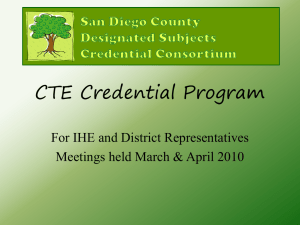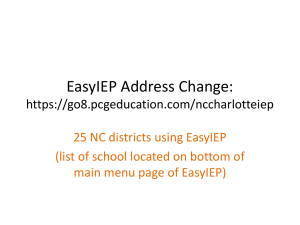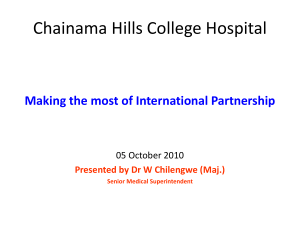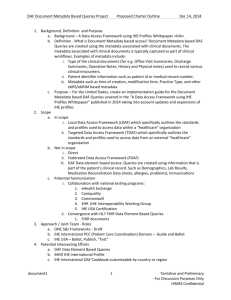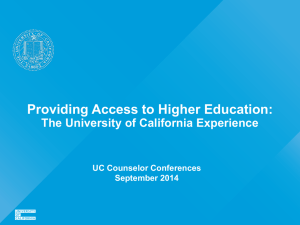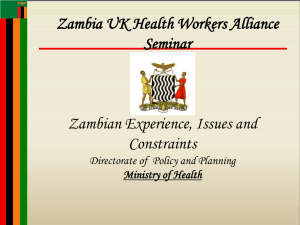Strengthening Effective Partnerships Between Local Education
advertisement
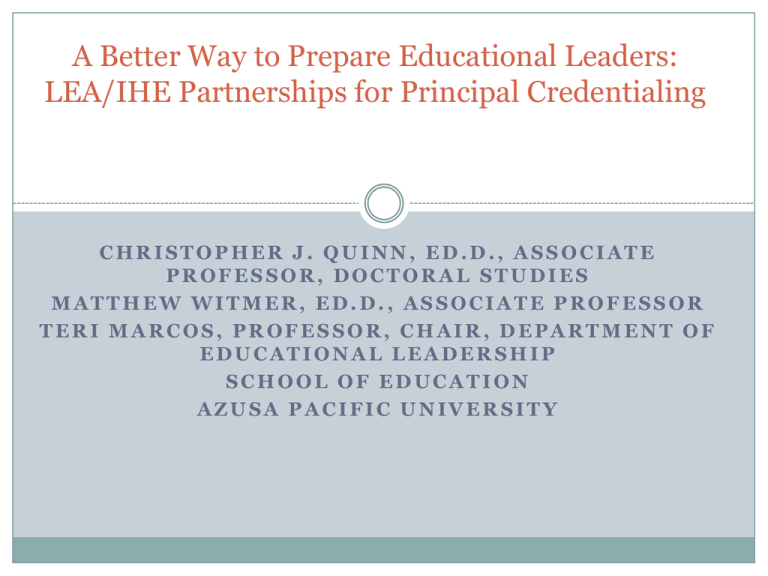
A Better Way to Prepare Educational Leaders: LEA/IHE Partnerships for Principal Credentialing CHRISTOPHER J. QUINN, ED.D., ASSOCIATE PROFESSOR, DOCTORAL STUDIES MATTHEW WITMER, ED.D., ASSOCIATE PROFESSOR TERI MARCOS, PROFESSOR, CHAIR, DEPARTMENT OF EDUCATIONAL LEADERSHIP SCHOOL OF EDUCATION AZUSA PACIFIC UNIVERSITY Need for LEA/IHE Partnerships Current Demand for Higher AYP/API scores More English learners re-designated Lower student retention rates Lower drop-out rates Higher percentages of students in advanced math, science, AP classes Higher percentage of students completing a-g requirements Higher percentage of seniors enter 4-year colleges IHE/LEA Partnership Defined The formal agreement between a school and/or district and an accredited educational leadership program to train aspiring administrators to lead schools Why More Partnerships are Need 1. High number of administrators ready to retire 2. Dwindling pool of qualified applicants 3. Current system is not working well Partnerships are Mutually Beneficial LEA needs effective, research-based ideas to meet academic and social goals IHE needs students, relevance, and data for research publications Questions to Answer before forming a Partnership 1. 2. 3. 4. 5. 6. 7. Does the IHE have the resources and expertise? Does the LEA have qualified candidates? Will IHE modify its curriculum to meet LEA needs? Is there mutual trust? Will IHE bring relevant research? Will LEA be willing to implement relevant research? Are both sides willing to collect and analyze data to determine effectiveness? Components of an Effective Partnership Focus on student learning Prepare principals to be instructional leaders Align program with California Professional Standards for Educational Leaders (CPSELs) Include real-world, problem-based learning Appoint instructors who integrate research and reality Emphasize results Promote professional reflection on research and work Recruiting Participants Recruits demonstrate four professional elements in their recent experience (Quinn, 2005): 1. ongoing involvement in professional development 2. demonstrated knowledge of technology 3. ability to increase student achievement 4. experience with entire school community Customized Partnerships Partnership curriculum reflects the LEA’s: Politics, Culture, Centralized or decentralized, Student academic and social data, Future needs, Supply and demand for candidates and administrators, Demographics. Continuous Improvement Analyze and revise Data-driven decisions Includes relationships in the partnership Focus is on results Systems Approach Changes in one area usually require changes in another Seeing the program as an integrated whole Example: data indicate change is needed in curriculum and practice Recommendations for Effective Partnerships LEA: focus on student outcomes IHE: focus on developing capacity to produce effective leaders Examples of Partnerships Aspiring Principal Program: Providence Public School District and the University of Rhode Island Aurora (Colorado) Public Schools Leadership Academy and the University of Colorado San Diego Unified School District and the University of San Diego References Barnett, D. (2004). School leadership preparation programs: Are they preparing tomorrow’s leaders? Education, 125(1), 121-129 Beering, Steven et al. (2007). National action plan for addressing the critical needs of the U.S. science, technology, engineering, and mathematics education system. National Science Board. Washington D.C. Brumley, C., (2010). Situating literacy leadership within the ISLLC standards for education administration. Scholar-Practioner Quarterly, 4(3), 207-218. Digby, A. D., Gartin, B. C. (1993). Developing effective university and public school partnerships. Clearing House, 67(1), 37-39. Dunbar, K., & Monson, R. J. (2011). Fellowship Connects principal learning to student achievement. Journal of Staff Development, 32(1), 40-43. Ed.gov. (2010). US Department of Education: School Leadership Program. Retrieved from http://www2.ed.gov/programs/leadership/2010awards.html Horwitz, J., Bradley, J., & Hoy, L. (2011). Identity crisis: External coaches struggle to clarify roles and maintain focus on student learning. Journal of Staff Development, 32(1), 30-38. Jackson, A.(2007). Preparing first-time leaders for an urban public school district: An action research study of a collaborative district-university partnership. Journal of School Leadership, 17(5), 540-569. References Miley, E. (2002). The Highly Qualified Leaders Project. http://www.ride.ri.gov/hqlp/Recruitment_Candidate_Pool/ProvidenceLEAD.aspx National Comprehensive Center for Teacher Quality (2007). Key issue: Improving the preparation of school and district leaders. Retrieved from: http://www2.tqsource.org/strategies/leadership/ImprovingLeaderPrep.pdf Killion, J. (2011). The perfect partnership: What it takes to build and sustain relationships that benefit students. Journal of Staff Development, 32(1), 11-15. Koch, S., & Borg, T. (2011). Real-time learning, real-world teaching: University teams with school district to improve curriculum and instruction. Journal of Staff Development, 32(1), 26-29. Lefever-Davis, S., Johnson, C., & Pearman, C. (2007). Two sides of a partnership: Egalitarianism and empowerment in school-university partnerships. Journal of Educational Research. 100(4). 204-210. Doi:10.3200/JOER.100.4.204-210 Levine, A. (2005). Educating school leaders. Retrieved from http://www.edschools.org/pdf/Embargoed_Report_050315.pdf Martin, M. B. (2010). Bridge the divide: A school district and university join forces to shrink the gap between principal preparation and practice. Principal, 90(3), 28-33. McLaughlin, C., & Black-Hawkins, K. (2007). School-university partnerships for educational researchdistinctions, dilemmas and challenges. The Curriculum Journal 18(3), 327-341. doi:10.1080/095851701589967 Myran, S., Crum, K. S., & Clayton, J. (2010). Four pillars of effective university-school district partnerships: Implications for educational planning. Educational Planning, 19(2), 46-60. Quinn, T. (2005). The principal university connection. Principal, 84(5), 12-16. Sacramento County Office of Education. (2011). Notes from common core standards: AICCU deans of education capital meeting. February 16, 2011. References Senge, P. (1990). The fifth discipline: The art and practice of the learning organization. New York: Doubleday/Currency, p. 81. Simmons, J. C., Grogan, M., Jones Preis, S., Matthews, K., Smith-Anderson, S., Walls, B. P., Whitaker, K. (2006). Preparing future school principals. Retrieved from http://www.nassp.org/portals/0/content/54438.pdf



